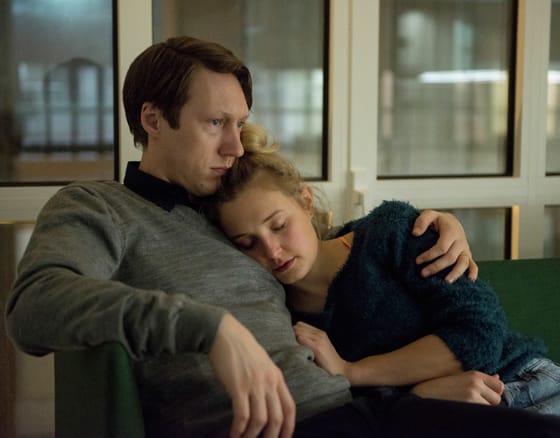Charlotte (Ine Marie Wilmann), a children's dance instructor, lives a life of seeming independence. When Homesick, Norwegian director Anne Sewitsky's third feature film, opens, Charlotte's father is on his deathbed and her mother (Anneke von der Lippe) is thereby preoccupied. At her best friend's wedding, she notes that she has a half-brother she's never met, suggesting a sort of disparity in her family, which is later reiterated by observations about the cold, but friendly, relationship she has with her mother, whose interest in academia and sidebar projects distracts her from conventional family norms.
Sewitsky, in trying to make an observational character drama, avoids exposition when possible and evades superfluous, or contextualizing stylization. While Homesick occasionally has exceptional cinematography, the style is loose and realist, meaning that Charlotte's story is limited to the experiences she has just prior to and following her father's death.
The chief instigator of conflict here is the introduction of her half-brother, Henrik (Simon J. Berger). He's initially dismissive of his sibling, harbouring a jealousy of her and a rage for the mother that abandoned him, but eventually warms up when Charlotte persists. And once a minor connection is established, he pursues her sexually, leading to the chief driver of this narrative: their incestuous affair.
Henrik's disposition is quite cold and aloof, manifesting in a rather intense, passionate series of rather explicitly outlined sexual encounters. Charlotte, who spends most of the film being quite agreeable and passive, appears to be seeking affection regardless of how it presents itself. This is later reiterated by her perturbed best friend, who notes Charlotte's tendency to latch onto people and insert herself into their lives.
While this character attribute and the rationale for it are shrewdly assessed, the major flaw in Homesick is that it's told rather than shown. There are no secondary storylines or stylizations to denote Charlotte actually being as clingy as her friends assert, and the lack of affection her mother demonstrates is similarly only verbalized as fact rather than shown through actions or reactions. These are things that wouldn't have been difficult to insert into the film, as much of the screen time is often depicting Charlotte doing rather mundane things involving work and commuting. Had these psychological components been visualized, there might be more emotional punch towards the end of this character drama when the tears start flowing and secrets are exposed.
Still, the manner in which the relationship between these half-siblings unfolds and is depicted is rather effective. Sewitsky uses sexuality and its visual presence to add a component of motivation and realization, giving Homesick a natural, intuitive sense of tragedy. Similarly, why everyone is the way they are is shrewdly considered — it's just unfortunate that more effort wasn't made in fleshing out secondary storylines or inserting some sort of sideline trajectory to make the story work in an emotional sense. Everyone around Charlotte and Henrik seems to exist only to aid in the basic Freudian realizations that oddly revert to a traditionalist view of family dynamics when all is said and done.
(Maipo Film)Sewitsky, in trying to make an observational character drama, avoids exposition when possible and evades superfluous, or contextualizing stylization. While Homesick occasionally has exceptional cinematography, the style is loose and realist, meaning that Charlotte's story is limited to the experiences she has just prior to and following her father's death.
The chief instigator of conflict here is the introduction of her half-brother, Henrik (Simon J. Berger). He's initially dismissive of his sibling, harbouring a jealousy of her and a rage for the mother that abandoned him, but eventually warms up when Charlotte persists. And once a minor connection is established, he pursues her sexually, leading to the chief driver of this narrative: their incestuous affair.
Henrik's disposition is quite cold and aloof, manifesting in a rather intense, passionate series of rather explicitly outlined sexual encounters. Charlotte, who spends most of the film being quite agreeable and passive, appears to be seeking affection regardless of how it presents itself. This is later reiterated by her perturbed best friend, who notes Charlotte's tendency to latch onto people and insert herself into their lives.
While this character attribute and the rationale for it are shrewdly assessed, the major flaw in Homesick is that it's told rather than shown. There are no secondary storylines or stylizations to denote Charlotte actually being as clingy as her friends assert, and the lack of affection her mother demonstrates is similarly only verbalized as fact rather than shown through actions or reactions. These are things that wouldn't have been difficult to insert into the film, as much of the screen time is often depicting Charlotte doing rather mundane things involving work and commuting. Had these psychological components been visualized, there might be more emotional punch towards the end of this character drama when the tears start flowing and secrets are exposed.
Still, the manner in which the relationship between these half-siblings unfolds and is depicted is rather effective. Sewitsky uses sexuality and its visual presence to add a component of motivation and realization, giving Homesick a natural, intuitive sense of tragedy. Similarly, why everyone is the way they are is shrewdly considered — it's just unfortunate that more effort wasn't made in fleshing out secondary storylines or inserting some sort of sideline trajectory to make the story work in an emotional sense. Everyone around Charlotte and Henrik seems to exist only to aid in the basic Freudian realizations that oddly revert to a traditionalist view of family dynamics when all is said and done.




